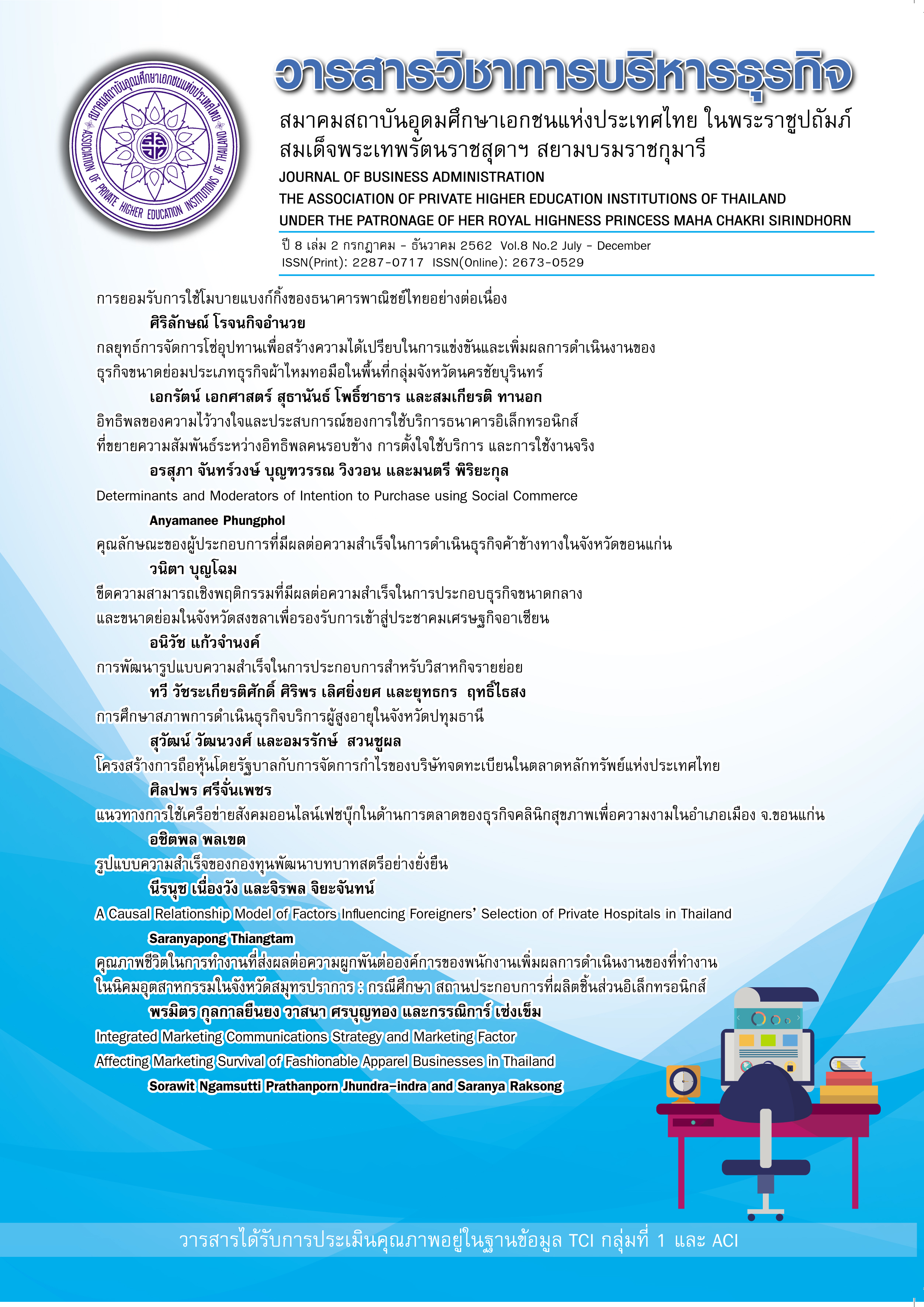Supply Chain Management Strategies to Enhance Competitive Advantage and Increase Performance of Hand-woven Silk Small Business in Nakornchaiburin Provincial Cluster
Keywords:
Supply Chain Management, Competitive Advantage, Business Performance, Small Business, Hand-woven SilkAbstract
The purposes of this research were 1) to study the important level of supply chain
management, competitive advantage, and business performance 2) to analyze the causal factors
that influence the business performance 3) to establish supply chain management strategy which
enhancing the business performance. The target samples were Nakhon Chaiburin provincial cluster
area. The researcher collected data by mixed research method. The data were collected by
questionnaires with 500 people and in-depth interviews with 12 people and analyzed by descriptive
statistical method, structural equation and content analysis. The result parts of the management
priority levels of the supply chain, which entrepreneurs most focused on backward the supply
chain, focus advantage and management processes within the business. The model was consistent
with the empirical data as the CMIN/df=1.659, CFI=0.988, GFI=0.937, AGFI=0.920, NFI=0.971, IFI=0.988,
RMR=0.018 and RMSEA=0.036 is showed that the variables in the structural equation are well
predictable and acceptable. The creation of strategies were divided into 3 parts: 1) the strategic
integration between backward the supply chain and business 2) the strategic integration within the
business 3) the strategic integration between forward the supply chain and business. By using
supply chain management strategies will gain to enhance competitive advantage and increase
performance of business.
References
Agyapong, A., Ellis, F., & Domeher, D. (2016). Competitive strategy and performance of family businesses: moderating effect of managerial and innovative capabilities. Journal of Small Business and Entrepreneurship, 28(6), 449-477.
Baudino, C., Giuggioli, N. R., Briano, R., Massaglia, S., & Peano, C. (2017). Integrated methodologies (SWOT, TOWS, LCA) for improving production chains and environmental sustainability of kiwifruit and baby kiwi in Italy. Sustainability, 9 (1), 1-18.
Best, J.W., & Kahn, J.V. (2014). Research in Education (8th ed.). New York: Allyn and Bacon.
Brian, D. (2015). Distinguishing Earth, Water, Fire, and Air: Factor Analysis to Determine the Four Fundamental Elements of State Capability. Boston: Harvard Business School Press.
Brown, T. A. (2015). Confirmatory Factor Analysis for Applied Research. (2nd ed.) New York: Guilford.
Chen, I.J., & Paulraj, A. (2004). Understanding supply chain management: critical research and a theoretical framework. International Journal of Production Research, 42 (1), 131-163.
Chopra, S., & Meindl, P. (2010). Supply Chain Management :Strategy, Planning and Operation. New Jersey: Pearson Prentice Hall.
Christos, S.T., Konstantinos, G.Z., & Alan, H. (2014). Developing a conceptual model for examining the supply chain relationships between behavioural antecedents of collaboration, integration and performance. The International Journal of Logistics Management, 25 (3),418-462.
Gaskin, J. E. (2014). Partial least squares (PLS) structural equation modeling (SEM) for building and testing behavioral causal theory : when to choose it and how to use It. IEEE Transactions on Professional Communication, 57(2), 123-146.
Grades, E. (2014). Structural Equation Modelling with Latent Variables. German: Heinrich-Heine-University.
Hair, J.F., Hult, G.T., Ringle, C.M., & Sarstedt, M. A. (2017). Primer on Partial Least Squares Structural Equation Modeling (PLS-SEM). Washington DC: Prentice Hall.
Huo, B., Qi, Y., Wang, Z., & Zhao, X. (2014). The impact of supply chain integration on firm performance : the moderating role of competitive strategy. Supply Chain Management :An International Journal, 19(4), 369-384.
Johnston, M., Dixon, D., Hart, J., Glidewell, L., Schröder, C., & Pollard, B. (2014). Content validity: a quantitative methodology for assessing content of theory-based measures, with illustrative applications. Journal of Health Psychology, 15 (3), 240-257.
Kaplan, R.S., & Norton, D.P. (1996). The Balanced Scorecard :Translating Strategy into Action. Boston:Harvard Business School Press.
Karami, A., Sahebalzamani, S., & Sarabi, B. (2015) The influence of HR practices on business strategy and firm performance: the case of banking industry in Iran. The IUP Journal of Management Research, 15 (1), 30-53.
Kline, R. B. (2016). Principles and Practice of Structural Equation Modeling (4th ed.). New York: The Guilford Press.
Nawaz, M., & Bhatti, G. A. (2018). The content analysis of the strategic management studies in the last 15-years: 2001-2016. International Journal of Information, Business and Management,10 (1), 246-254.
Özdemir, Ai., Simonetti, B., & Jannell, R. (2015). Determining critical success factors related to the effect of supply chain integration and competition capabilities on business performance. Quality & Quantity, 49(4), 1621–1632.
Oyewobi, L.O., Windapo, A.O., & James, R.B. (2015). An empirical analysis of construction organization competitive strategies and performance. Built Environment Project and Asset Management, 5 (4), 417-431.
Pallant, J. (2016). SPSS Survival Manual: A Step By Step Guide to Data Analysis Using SPSS Program (6th ed.). London, UK: McGraw-Hill Education.
Porter, M.E. (1980). Competitive Strategy. Boston: Harvard Business Review.
Provincial Community Development Office of Buriram. (2016). Silk Trader Statistics. Buriram: Provincial Community Development Office of Buriram.
Provincial Community Development Office of Chaiyaphum. (2016). Silk Trader Statistics. Chaiyaphum: Provincial Community Development Office of Chaiyaphum.
Provincial Community Development Office of Nakhon Ratchasima. (2016). Silk Trader Statistics. Nakhon Ratchasima: Provincial Community Development Office of Nakhon Ratchasima.
Provincial Community Development Office of Surin. (2016). Silk Trader Statistics. Surin: Provincial Community Development Office of Surin.
Stephen, S., & Molly, F. (2014). Validity Evidence based on Test Content. Psicothema, 26 (1), 100-107.
The Office of SMEs Promotion. (2018). SME Situation Report 2018. Bangkok: The Office of SMEs Promotion (OSMEP).
The Office of Strategy Management, Lower Northeast 1. (2017). Development Plan for the Lower Northeast Province Group 1, 4 Years Period (2018 - 2021). Nakhon Ratchasima: (Copied).
Todd, F.L. (2017). Evidence regarding the internal structure: confirmatory factor analysis. Measurement and Evaluation in Counseling and Development, 50 (4), 239-247.
Xu, D., Huo, B., & Sun, L. (2014). Relationships between Intra-organizational Resources, Supply Chain Integration and Business Performance : An Extended Resource-based View. Industrial Management & Data Systems, 114 (8), 1,186-1,206.
Zhao, L., Huo, B., Sun, L., & Zhao, X. (2013). The Impact of supply chain risk on supply chain integration and company performance: A global investigation. Supply Chain Management : An International Journal, 18 (2),115-131.

Downloads
Published
How to Cite
Issue
Section
License
บทความที่ลงตีพิมพ์ในวารสารวิชาการบริหารธุรกิจ สมาคมสถาบันอุดมศึกษาเอกชนแห่งประเทศไทยต้องเป็นบทความที่ไม่เคยได้รับการตีพิมพ์เผยแพร่ หรืออยู่ระหว่างการพิจารณาตีพิมพ์ในวารสารอื่นๆ การละเมิดลิขสิทธิ์เป็นความรับผิดชอบของผู้ส่งบทความโดยตรง

